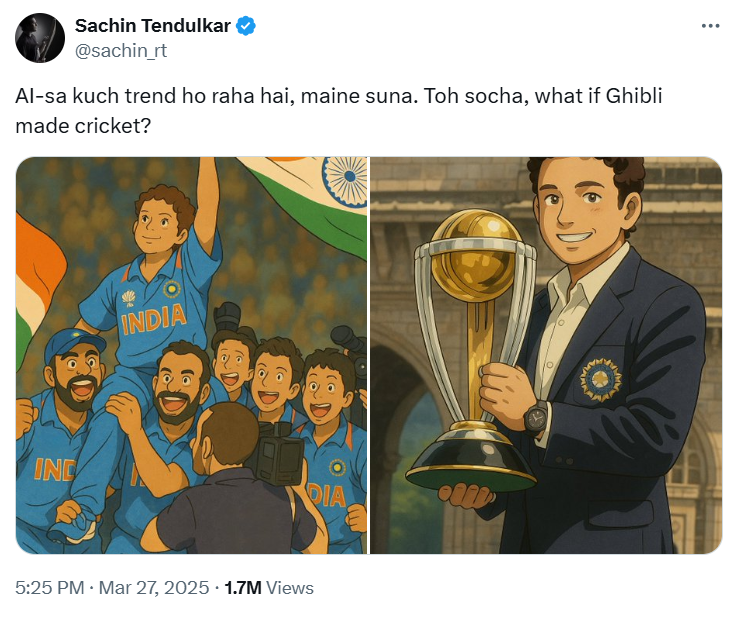Table of Contents
The Global Explosion
When OpenAI’s GPT-4o launched its image generation feature, something magical happened. Suddenly, anyone could transform mundane photos into dreamlike Ghibli-inspired artwork. It started as an experiment, a simple fusion of nostalgia and technology. Then, almost overnight, the internet went wild – from memes to personal portraits, everything was getting the “Ghiblized” treatment.
The Enchanting World of Studio Ghibli
Imagine a world where animation isn’t just a cartoon, but a portal to extraordinary emotions. That’s the magic of Studio Ghibli – a legendary Japanese animation studio founded in 1985 by visionary creators Hayao Miyazaki, Isao Takahata, and Toshio Suzuki. Known for hand-drawn animations with breathtaking detail, Studio Ghibli has created cinematic masterpieces like “Spirited Away” and “Howl’s Moving Castle” that transcend age and culture. Their signature style? Pastel color palettes, intricate backgrounds, and stories that touch the human soul.
Hayao Miyazaki stands as a resolute guardian of artistic authenticity in the face of technological invasion. His 2016 statement resonates with profound conviction: “I am utterly disgusted. If you really want to make creepy stuff, you can go ahead and do it. I would never wish to incorporate this technology into my work at all.”
For Miyazaki, AI-generated art represents more than a technical innovation—it’s an “insult to life itself.” His critique cuts deep, challenging the very essence of creativity. The human touch, the nuanced emotion, the painstaking frame-by-frame craftsmanship cannot be replicated by algorithms.
Beyond Miyazaki’s perspective, three critical concerns emerge:
- Copyright Erosion : AI tools systematically train on existing artworks without proper compensation or consent, potentially stealing decades of creative labor.
- Economic Displacement: Professional artists face unprecedented threat as AI can generate similar-style artwork instantaneously and at minimal cost.
- Creative Authenticity: The unique emotional depth and intentional imperfections that define human creativity risk being flattened into algorithmic precision.
OpenAI acknowledges these challenges, implementing restrictions to prevent direct artist style imitation—a small step in a complex technological landscape.
Indian Brands Riding the Ghibli Wave
1. Swiggy & Zomato
Swiggy took food storytelling to another level. Each dish became a character, each delivery a potential adventure, showcasing food as more than just a meal. Zomato transformed food delivery into a magical narrative. Their AI-generated images turned ordinary meal deliveries into whimsical adventures, making every order feel like a scene from a Miyazaki film.
https://www.instagram.com/movesofmarketing/p/DHtHekxTEAi/?img_index=1
2. Britaniannia X Prashant Croisant
https://www.instagram.com/marketingmind.in/p/DHtPeCzBkjA/?locale=zh-hans&hl=fi&img_index=1
3. Cricket legend Sachin Tendulkar

4. Maharashtra CM Devendra Fadnavis

Not only them but Fabindia & Tanishq are blending traditional Indian brands blended AI with heritage, creating visuals that merge handcrafted authenticity with whimsical animation—a perfect appeal for millennials craving cultural nostalgia. Myntra & Nykaa reimagined their products in fairytale-like universes, making everyday apparel and cosmetics feel enchanted, aspirational, and instantly shareable.
Why This Strategy is a Game-Changer
- Emotionally Powerful: Ghibli-style animation taps into deep-rooted nostalgia, forging instant emotional bonds with consumers.
- Viral by Design: AI-generated visuals are visually arresting, unique, and meme-worthy, boosting organic reach and engagement.
- Marketing That Feels Like Art: Instead of being intrusive ads, these AI creations feel like stories people want to experience.
- Cost-Effective Creativity: No need for expensive productions—AI delivers stunning visuals at a fraction of the cost.
This isn’t just a passing trend—it’s the dawn of a new era. Interestingly, this trend emerged despite Hayao Miyazaki’s famous critique of AI-generated art, where he once said he was “utterly disgusted” by such technology. The irony? The very technology he criticized is using his own style to become a global phenomenon, his exact fear with AI.
Aditya Tare, an influential social media writer, says that AI-generated Studio Ghibli art might seem fun, but it’s blatant plagiarism, undermining Miyazaki’s decades of artistry. Beyond that, the environmental toll is staggering—10 million liters of water wasted daily to create these images. Imagine if that power fueled AI for medicine, climate research, or disaster prevention instead. Priorities matter.
But beyond the world of AI, this teaches us that businesses need to create Art, not Ads – marketing today isn’t about selling—it’s about creating experiences that people want to share. And Indian brands are proving that the perfect blend of nostalgia and AI innovation is a game-changer. Are you ready to reimagine your marketing?

